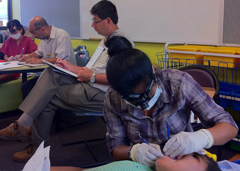The use of fluoride is back in the news thanks to local councils in Queensland being given the right to vote on whether to retain its use in their water or not.
While the use of fluoride has long been proven to help fight tooth decay, little long-term research has been done in isolated communities, until now.
Led by Professor Newell Johnson, a team from Griffith Health Institute’s Population and Social Health Research Group travelled to Bamaga, at the tip of Cape York.
Bamaga is actually five (mostly Indigenous) communities, Seisia, New Mapoon, Injinoo, Umagico and Bamaga with a large army base also close by.
In 2006 fluoride was introduced into the water system and the army conducted baseline research on the oral health of the Indigenous residents. It is this data Professor Johnson is following up.
School table to dental chair
The team, which included Dr Surani Fernando, Professor Ratilal Laloo, A/Professor Jeroen Kroon and Dr Ohmar Tut established a makeshift dental “surgery” in classrooms of several Bamaga Schools using head-torches and school tables.
“We organised to take a team up there to work in parallel with Queensland health staff and did as many basic dental checks as possible, 339 primary and high school children in the end,” Professor Johnson said.
“The study produced an enormous amount of data, which we’re sifting through right now.
Could local diet confound good intentions?
“The conflicting part of this research is the amount of sugary drinks that are consumed by the children. Ultimately a fluoridation system can only do so much to counter the wave of sticky stuff being drunk.
“It may take a comparative study with children from another Indigenous community to find out the difference an intervention like this makes.”
Professor Johnson hopes the Bamaga study is followed up over the long-term.
